Calvary, Clifton priest helps create communities of “joyful belonging.”

“No matter what your family constellation looks like”

Calvary, Clifton priest helps create communities of “joyful belonging.”

“No matter what your family constellation looks like”

You should have received this edition of Connections shortly after the Standing Committee’s announcement about nominees for the Tenth Bishop of Southern Ohio. The process for submitting additional nominations by petition will close soon. Then the meet-and-greet tour for all the nominees will come in early September, followed by the electing convention on September 30. Thousands of hours from the people and clergy of Southern Ohio— Standing Committee, Nominating and Transition Committees— have brought us this far. It is also good to remember that the nomination process—essays, references, interviews— depends on the willingness of priests prepared to offer themselves for their work of discernment, and ours.
I have engaged as an elector in numerous episcopal elections, and a candidate in two, and have some experience of the excitement and anxiety an electing convention can generate. Here are a few ways to make the most of the season’s energy and minimize the worry.
• Share both the excitement and the worry among friends. Doing so breaks down isolation and eases any burden these emotions might bring. Social media, however, may not be your friend during a church season like this. They are good vehicles for sharing information but tend to roil the emotions. Which leads to my next point.
• Gossip quickly makes a bishop election toxic. Gossip proves more damaging in these times than the mere untruth of it might suggest. It becomes corrosive to the community at large, undermining trust. Any statement including the phrase “the fix is in” should trigger skepticism. Same for any reference to a “reliable source” whom, of course, the gossip cannot name.
• Work to build trust in the whole process. There are good agents for this diocese at every turn of the journey toward the election. Standing, Nominating and Transition Committees—all have sought out the best practices. All have kept appropriate confidences while sharing broadly the information we need to know. They have borne burdens on behalf of us all, and they deserve trust as a default assumption from us, not suspicion.
• Honor the nominees. Those on the ballot have given themselves for the purpose of a public work of discernment in our election processes. I firmly believe that every nominee has something to bring to the conversation and helps clarify our discernment, nothing being wasted in God’s economy. Acknowledge, however, the emotional, spiritual, and physical burdens they have all faced. It is exhausting for them all, and only one becomes bishop. Don’t forget the others.
• Listen to the nominees and how they speak about vocation. The canons (III.11.1) and the ordination rite (BCP, 517) make clear that a prerequisite for discernment to the episcopate is the election itself! Often we question our nominees in less than precise ways: “Why do you think you are called to be Bishop of Southern Ohio?” No one is so called until the clergy and people of a diocese say so. That’s what our canons and Prayer Book say. “What made you willing to be a nominee here?” might be a better question. Or “What about our diocese attracts you?” I remember the cringy rector from The Innocent Curate (Paris Leary’s 1963 novel) praying, “O God make me a bishop. But not of Nebraska.” Listen for any intimation like this.
• Remember the relational genius in our Anglican way of following Jesus. Remember that the meet-andgreet is a step along the way in building a long relationship (pray God!) with the next bishop diocesan. How we treat the nominees during the electing season may signal how we might treat a bishop over the long haul. We will interview them, yes, but in a real sense they will also interview us.
• Savor the energy of the convention itself. Electing a bishop, and being elected, is a sweet moment. Remember the inverse level of disappointment that will likely visit those not elected. The energy of the convention and election may lead us to forget them, and their irreplaceable contribution in the discernment.
• Pray always, and do not lose heart. Luke 18—Jesus himself—tells that story best.
In Chillicothe and other communities, parishes share clergy, and a sense of connection.
 BY KATHLEEN MOORE
BY KATHLEEN MOORE
Parishes experiment with hard conversations, celebration and commemoration.
BY NANCY BRYAN BY NANCY BRYANEditorial Staff editor
Jim Naughton writers
Nancy Bryan
Kathleen Moore
designer
Jacob Bilich canon for communications
Julie Murray
About the Magazine
Connections Magazine is published by the Diocese of Southern Ohio, 412 Sycamore Street, Cincinnati, OH 45202-4179.
This publication is funded by mission share payments to the diocesan operating budget and is available at no charge to all members of congregations in the Episcopal Diocese of Southern Ohio.
Change of Address
Send changes of address to: Connections Magazine 412 Sycamore Street Cincinnati, OH 45202-4179
BY NADYA RICHARDSON“No
As the Sesquicentennial approaches, parishes probe their past.
“One visit was all it took for me.” Mignonne Whitlow and her family found a home at St.
 Stephen’s.
Stephen’s.
At St. Stephen’s Church in Columbus, a story is told about a Black woman named Colleen Mitchell who visited the church one Sunday morning in the late 1950s. An usher approached her at the back of the church and suggested that she might be more comfortable at a nearby church. What distinguished that church—St. Philip—from St. Stephen’s went without saying.
“No,” replied Mitchell, a social worker with a masters in music from Ohio State. “I am where I belong.” And she took her service bulletin and sat down.
The people who tell that story include Mignonne Whitlow, Mitchell’s younger sister, who is now in her 90s and still active at St. Stephen’s, and Joseph Rutter, the church’s historian. Neither can say for sure whether the usher’s tone implied that he did not want Mitchell at St. Stephen’s, or whether he was actually concerned for her comfort and thought she might feel more at home at St. Philip Church, about 5 miles southeast.
But whatever the usher’s intentions, Colleen Mitchell knew her own mind. She stayed. And she flourished.
“Colleen was not a warrior,” her sister says of Mitchell, who died in 2002. “She was comfortable with her associations, and very active there.” And not only within the parish, but in the diocese and the wider church. Mitchell served on Diocesan Council, the Standing Committee, and the churchwide Board of Ecumenical Relations. For a time she was also lay minister of programs at St. Stephen’s and ecumenical relations officer for the diocese.
Not every parish has a Colleen Mitchell in its past. But through the Parish History Project, initiated by Bishop Wayne Smith and approved by the 2022 diocesan convention, the diocese has made a firm commitment to seeking a deeper understanding of its own history, particularly the role of race and racism in shaping the diocese, as it prepares to celebrate is sesquicentennial in 2025.
“As we look at 150 years it is important to look honestly,” says Robin Holland of St. Philip, Columbus, a member of the Parish History Project team that is overseeing the work on behalf of the Sesquicentennial Committee. “I think one thing we want to do is tell stories that haven’t been told. We want something that clearly identifies exactly who we are, what we’ve done as a diocese, what we could have done and didn’t do, the relationships among churches, the relations among churches and the diocese, and the relationship of our diocese to the larger church.”
To energize this work, the group has hired Donna DeBlasio, a public historian and professor emerita of history at Youngstown State University. She will work with 26 churches, including a mix of historically Black churches, churches born of outreach in immigrant communities, churches that took the lead in working toward LGBTQ equality, “mother churches” that planted other churches and suburban churches.
“Our diocese is kind of strange in the variety of landscapes we’ve got,” Holland says. Those landscapes range from major metropolitan areas to Appalachian river towns, and the task force is committed to representing each demographic and geographic region.
In addition to its congregationally based work, the diocese will also designate 10 individuals whose personal stories illuminate the larger story of the diocese, says the Rev. Karl Stevens, rector of St. Stephen’s, a member of the Sesquicentennial Committee and co-chair of the Reparations Task Force and the Parish History Project Team. The hope, he says, is to have a preliminary document to share at the 2024 diocesan convention and a book for the 2025 Sesquicentennial Celebration.
“We have been trying to push this project for a year and a half and only five parishes have been able to write these histories on their own,” Stevens says. “So that was the impetus behind hiring a historian.”
“The point isn’t to shame anyone. The point is to allow us to be truthful about all the different ways in which we both serve and fail to serve and grow in our understanding.”
The resolution approved by diocesan convention stresses the importance of “includ[ing] the voices of all including those who have been oppressed or marginalized,” particularly Black and Brown people.
“The point isn’t to shame anyone,” Stevens says. “The point is to allow us to be truthful about all the different ways in which we both serve and fail to serve and grow in our understanding.”
St Stephen’s, which sits about half a mile east of Ohio Stadium on the Ohio State University campus, is among the few parishes already deep into the process of researching its history. Their progress is due largely to the efforts of Rutter, who says he has been “a church history nerd” since childhood.
“It’s always fascinated me,” he says. “When you are really young the church looks so permanent and old. The building I attended as a kid was very Romanesque. I lived across the street. I had a lot of time to fantasize about it. We would play knights.”
Rutter, who came to Columbus as a freshman at Ohio State in 1968, can tell you that the current church building includes bricks made by Philander Chase for a building at Kenyon College that were then sold as a fundraiser after a fire, and that the

white stone that sits atop the cornerstone comes from Canterbury Cathedral.
In several years of research, he has woven together the story of two separate churches, both established by Trinity Church, Columbus, that merged uneasily in 1928. The Church of the Good Shepherd was founded in 1866 in the old Union Railroad Depot to minister to immigrant railroad, stockyard and industrial workers in a neighborhood called Flytown for the speed with which housing, often constructed of discarded packing materials, “flew” up.
While the church continued its work among industrial workers and immigrants, its liturgy became increasingly oriented to the educated classes. “Many of the founding families of Trinity and of Good Shepherd were some of the most philanthropic and generous benefactors of the community, but they were also conscious of their position within the educated and wealthy classes and had no intention of inviting the less advantaged folk to sit with them in church,” Rutter writes in “A Social History of St. Stephen’s Church, Columbus, Ohio.”
The other Trinity-sponsored church, the Chapel of the Holy Spirit, was founded in 1916 on the northern
edge of the quickly growing campus of the Ohio State University, which had been founded in 1878. In 1913, Bishop Boyd Vincent had established St. Hilda’s House on the southern edge of the campus as a residence for single female college students who were not yet allowed to live in the university’s dormitories, and the women of St. Hilda’s formed the altar guild of the new church.
The two parishes merged, largely because trends in real estate pushed many of Good Shepherd’s families into the bounds of Holy Spirit, its younger and more evangelically inclined neighbor. Within ten years, the newly named St. Stephen’s became one of the ten largest churches in the city.
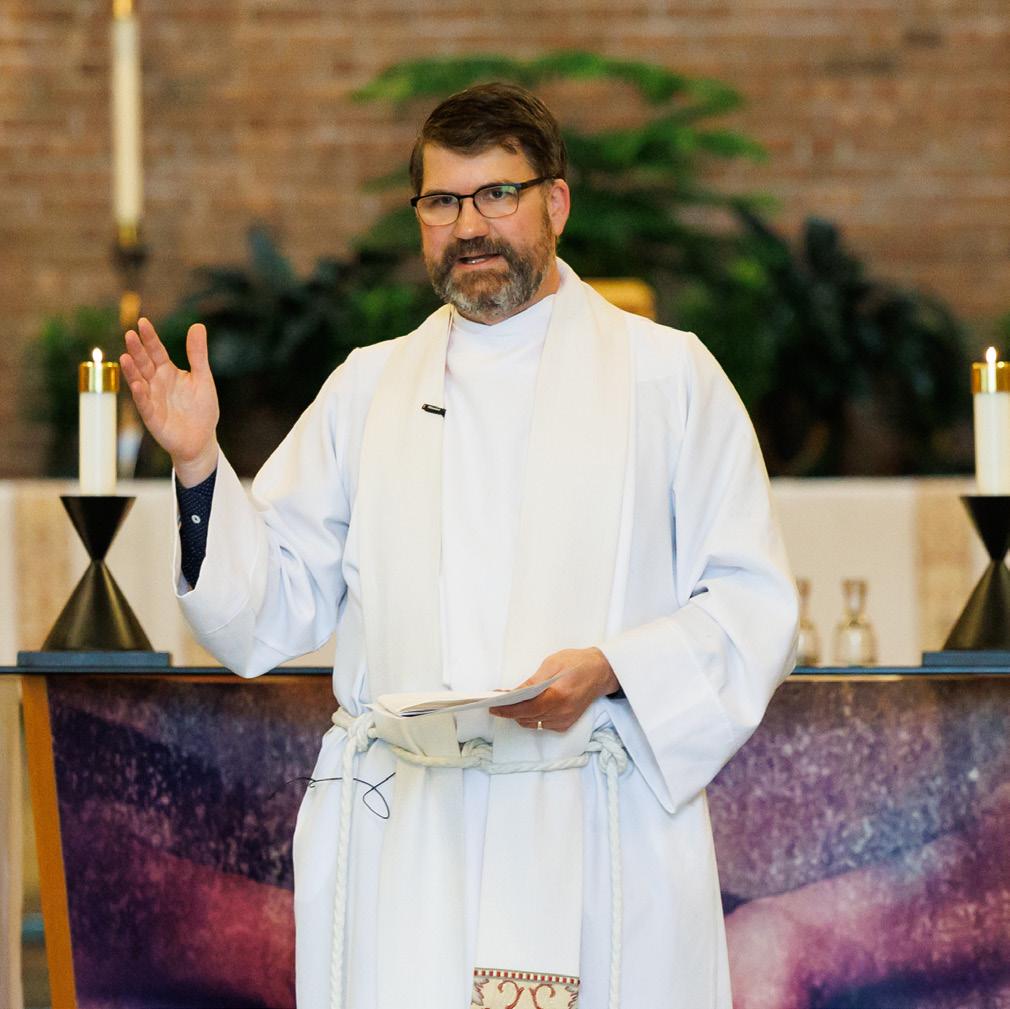
In the years after World War II, St. Stephen’s became known for its progressive stances on political issues. It had the honor of being picketed by the John Birch Society for its support of racial integration. In May 1970, when Ohio State closed its doors for two weeks to quell campus unrest after the Ohio National Guard killed four people at Kent State University, St. Stephen’s remained open and hosted the university’s faculty senate discussions about how to respond to the tensions.
Yet for all its progressivism, the congregation, whose modernist building was completed in 1952, had few Black members before Mitchell and, later,
her younger sister began attending in the wake of unpleasantness, the details of which Whitlow no longer remembers, at St. Philip, their previous parish.
“One visit was all it took for me, and there I stayed,” Whitlow says.
Despite the lack of Black parishioners, she felt welcomed. “It didn’t feel like people were going out of their way. It wasn’t like they saw a Black face and didn’t want to lose it. I felt very comfortable and I also felt they were comfortable having me there, and I think that was it more than anything.”
Whitlow stayed, raised her children, felt her faith deepening, became a regular pledger and was later part of the parish’s stewardship efforts. She was a mainstay of St. Stephen’s work with B.R.E.A.D., a congregation-based social justice advocacy organization, and most recently served on the Justice Ministry Team that facilitates St. Stephen’s participation in B.R.E.A.D.
In May she was inducted into the Society of St. Simeon and St. Anna. “Wow, that’s awesome,” she says when reminded of this honor.
Despite the legacy of Whitlow and her late sister, there are still few Black parishioners at St. Stephen’s, or at most churches in the diocese. The story of Black Episcopalians in most congregations across the country is a story of absence, and often intentionally so. Black Episcopalians were either intentionally segregated from white churches or chose to segregate themselves, and Robin Holland says it would be interesting to know which. Church investment followed the migration of white people from cities, a migration facilitated by highways built through primarily Black and mixed neighborhoods. Two of the diocese’s four historically Black parishes—St. Philip, Columbus and St. Margaret’s, Trotwood, lost buildings to highway development.
“I think this is an appropriate time to be thinking about migration to the suburbs and disinvestment in the city,” says Stuart Hobbs, director for education and training at Ohio State’s Center for Clinical and Translational Science, who is a member of St. Stephen’s and serves on the Parish History Project Team.
“It wasn’t necessarily always ‘We have to get away from the Black people or keep them out of the church,’
but that was sort of in the air,” says Hobbs, who holds a doctorate in history. “Richard Rohr said one of Paul’s great successes was talking about how whether Jew or Greek, slave or free, male or female, all were one in Christ, and how that was part of the great appeal to people of the Christian message at the time. That all people are equal is obvious, but that’s not really how things work in practice.”
The planners of the Sesquicentennial observance believe the parish history project will significantly deepen the diocese’s understanding of these issues.
“We are at a cultural moment that I think can only be defined as the death of Christendom, where
this historic allyship between the church and the state is coming to an end,” Stevens says. “That means the church has to rethink what it is. We do not know who we are if we are not the upholders and allies of the state.”
To discover this new identity, he says, the church needs to ask itself, “Where have we always been serving those who aren’t powerful?” And one way of doing that is to explore the “very mixed story” of the diocese’s history. But he says that it is, ultimately, a story of all of the parishes being “immersed in a Christian ethic that says we are to serve the least among us.”
Meanwhile at St. Stephen’s, the work continues.
Darien McCoy, the parish’s director of children and youth formation, arrived at the church in 2020 during the COVID pandemic. “The first service was outside, we were masked and the first thing I noticed was that I was the only person of color at the service,” he says. “But I didn’t think much of it. It was very welcoming. I felt I had landed in the right place.”
McCoy, who is biracial, worked as a summer camp counselor at Procter Center and spent a year in the Episcopal Service Corps at Brendan’s Crossing in Cincinnati before accepting his job at St. Stephen’s. He felt encouraged by the church’s Black Lives Matter and LGBTQ flags, by Stevens’ presence at a Black Lives Matter protest in the wake of the murder of George Floyd by a Minneapolis police officer, and by conversations he had had with Stevens and others.

All but one of his students is white, McCoy says, but the class meets beneath “my first purchase for my classroom,” a poster of Jesus “with dark hair, lips like mine and a nose like mine, and he is holding the elements of Communion.” One of his proudest days, he says, is when one of his students, finding some materials previously used in formation programs at the parish, wondered aloud if Jesus looked like a white European, and then decided that he couldn’t have.
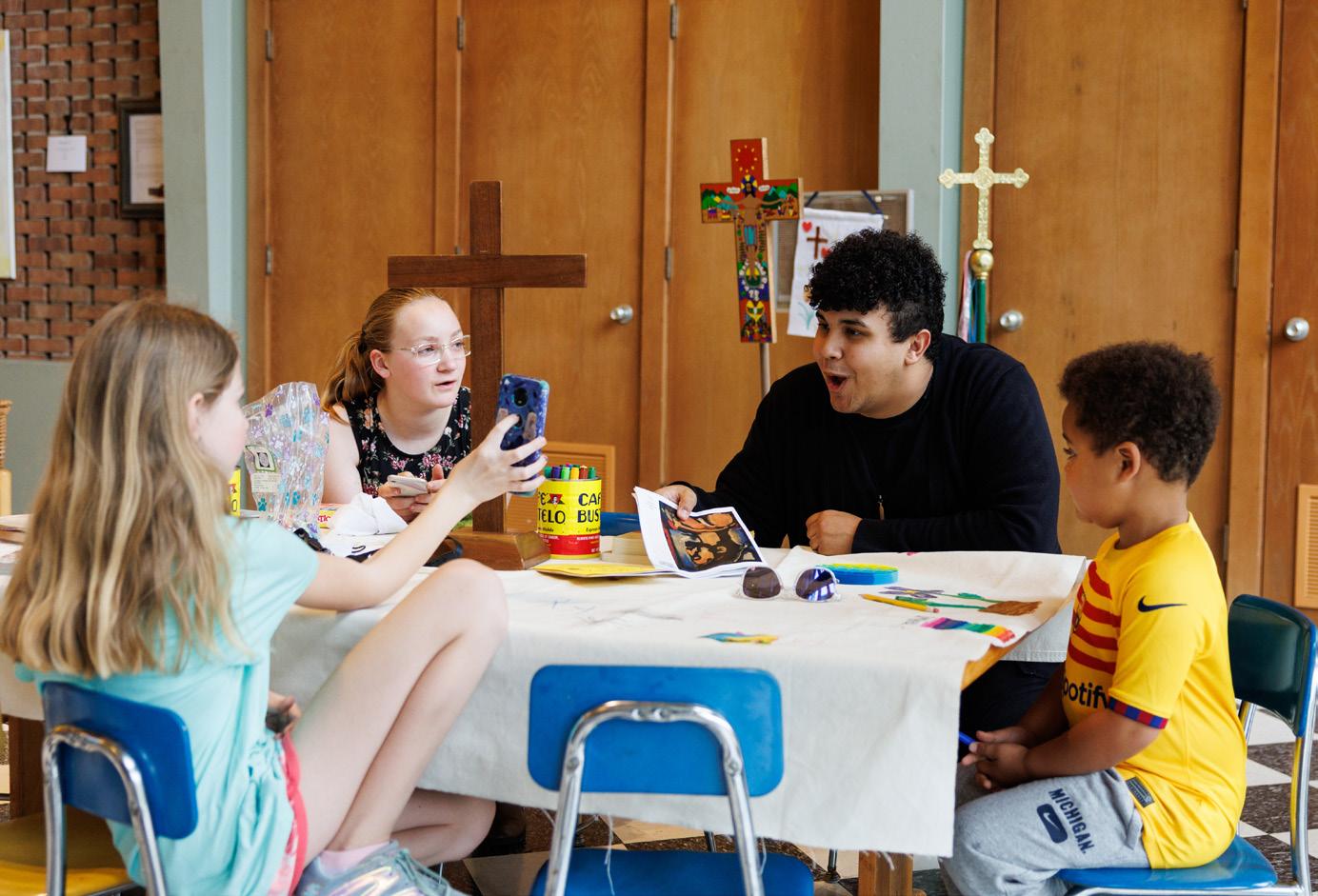
Calvary, Clifton priest helps create communities of “joyful belonging.”
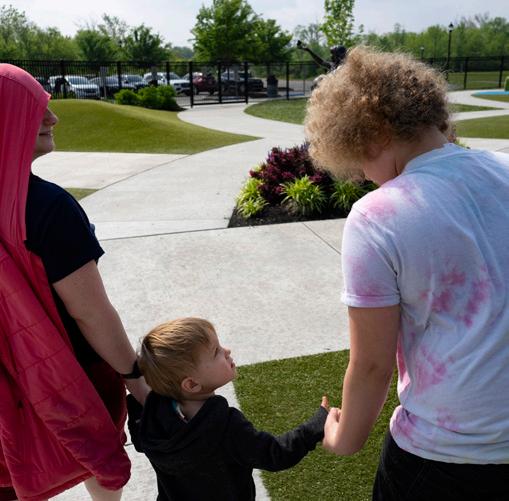





When Sherry Darling got an email through her family’s foster agency, inviting them to an event called “Tacos and Tie Dye” sponsored by a group called The Brood, she jumped on Google to learn more.
The agency had offered Darling’s two-mom, transracial family invitations to other events that Darling says they would not have been comfortable attending. But The Brood, which is led by the Rev. Olivia Hamilton, curate at Calvary Episcopal Church in Clifton, and supported by a grant from the diocese’s Commission on Congregational Life, proclaims on its website that “No matter what your family constellation looks like, you are welcome here.” Darling decided to take a chance.
“I took our younger son to the event and it was exactly what I was looking for,” she says. “It was an answer to prayer, as we had wanted more connection for our family and especially for our kids.”
The Brood, which describes itself as “LGBTQ+ affirming, trauma-informed, and … mindful of the ways that injustice and oppression impact individuals and families,” has been connecting foster, adoptive and kinship families since Hamilton, a foster and adoptive parent herself with her wife Molly McHenry, founded it in 2021. About twenty-five families currently participate in the group.
“I’m not entrepreneurial, but people keep hearing about it and I’m excited by the growth,” Hamilton says.
Before being ordained and called to Calvary in 2020, Hamilton was a hospital chaplain for children with mental illness in the Boston area and in Cincinnati. She brings those experiences to her work at Calvary, where she is responsible for youth ministry and “social justice broadly defined,” she says.

The parish “has long been a welcoming place for the LGBTQ community,” says vestry member Megan Rich. “That’s been evident from the first day we attended in many ways. So, the door was open for Olivia to build something really cool. She has such unique and interesting skills. I’m very grateful she is at our church.”
At The Brood’s first gathering, parents said they wanted to worship with their children, to have respites from child care, and to have a firmer support network. Darling says the group meets those needs for her family.
“The Brood offers people the opportunity to feel welcome, included, supported, whether they go to church or not,” she says. “It’s a space to bring concerns and fears along with joys and have people able to celebrate the big and the small. It’s a blessing to learn more about other people’s spiritual practices, to get a sense of how hard everyone is working for their community.”
In 2022, the Commission on Congregational Life decided to invest in The Brood’s potential with a three-year grant for program costs. With the support, Hamiltion has been able to offer monthly Pray + Play gatherings, occasional caregiver retreats, and microgrants for immediate needs of the group’s foster, adoptive, and kinship families. Recently, The Brood was able to purchase a therapeutic high chair for a family with a special needs child and to help a kinship family with a utility bill.
Hamilton views The Brood as the kind of ministry that is essential to the Episcopal Church’s future. “We, as a denomination, are in a position where if we don’t think critically, faithfully, about the future, we will be left in the dust,” she says. “Church is, and will continue to become, less relevant. We have to look at who in our community could we be walking alongside? Who
can we as people of faith accompany? It’s not about pledges or people in the pews, but being Jesus’ hands, heart, and feet in the world. Both queer and trans kids and foster and adoptive families have not had the most robust welcome.”
The Brood, says Hamilton, also inspired Divine, a program for queer and transgender middle and high school students and their families sponsored by Calvary, Clifton and Christ Church Cathedral, Cincinnati. The five-week program, which took place earlier this year, included dinner, conversations with adult mentors for the youth, and parent discussions facilitated by Mike Johnson, a member of the cathedral and principal of Summit Country Day School in Cincinnati. Most of the first participants were Episcopalians, but the group expanded to include people of other, or no, religious traditions.
Megan Rich participated in Divine with her child. “The large group experience at Divine included older youth,” she says. “My child and I both benefited from hearing the way they talked about scripture and the way they understood Jesus.”
Rich found the opportunity to talk with other parents especially helpful. “We are all struggling to sup-
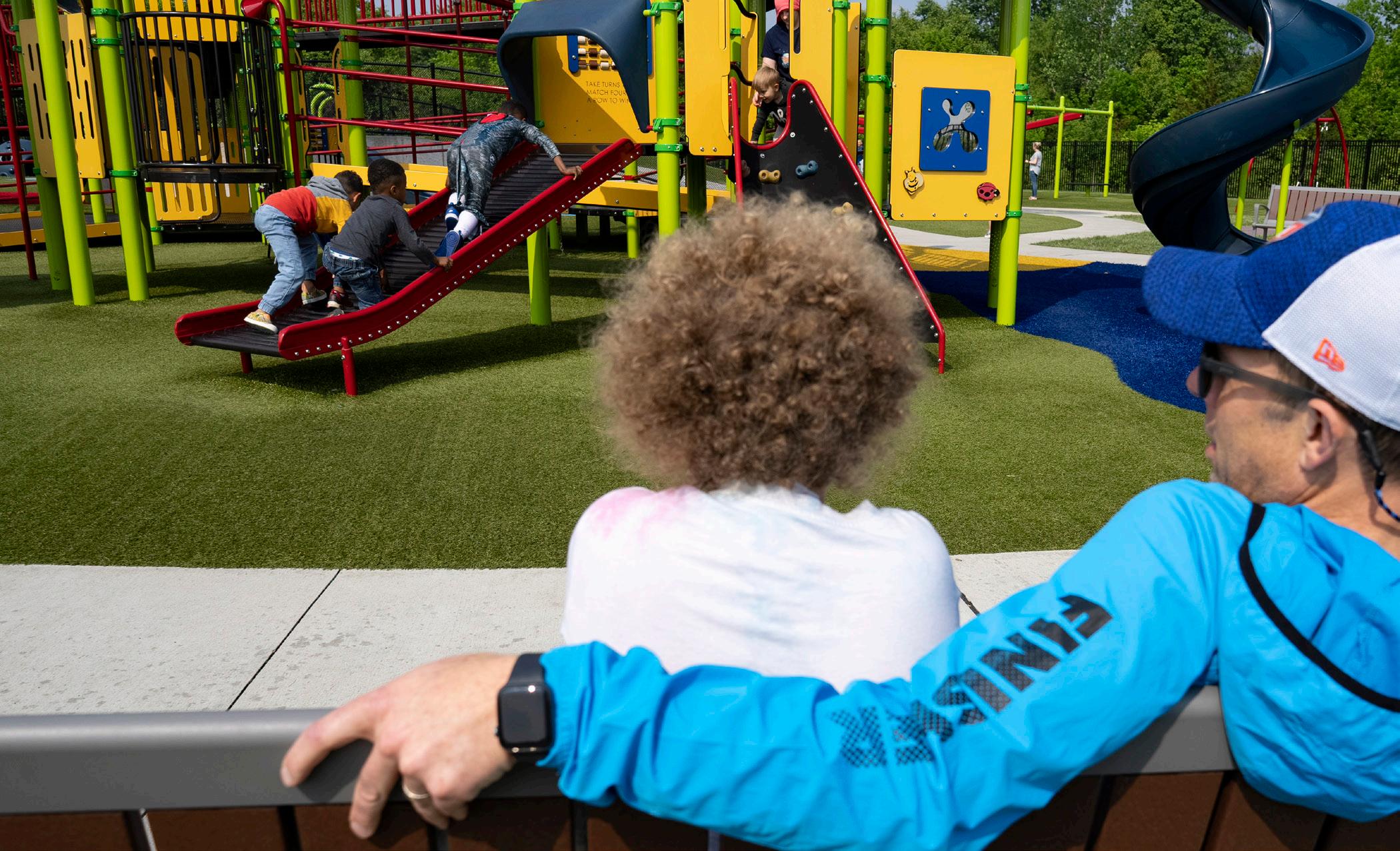
port our kids,” she says. “I don’t know my child’s experience. Exploring gender wasn’t an overt part of my childhood. To learn new language, to talk with parents further along this journey, or newer to it, who can offer a new perspective became a safe space to talk, always with the goal of supporting our children.”
One of the primary benefits of Divine, she says, was knowing that “the door to the church remains open to my child. They know that there is a safe space within our church.”
Hamilton sees both benefit and challenge for the church in these ministries. “While in a broad sense we’ve said, ‘This is our church and you’re welcome to come,’ both The Brood and Divine upend the idea of where church ends and community begins; the walls are more porous. This is outreach as well. Who are we reaching out to and what is our motivation?
“For me, I’m compelled by the story of Jesus, love, and inclusion being a good story that needs to be told. I want to tell it to as many people as possible, meeting people where they are, tending to their hurt and creating a community of joyful belonging.”
The Bishop Nominating Committee has submitted a slate of four candidates. Additional candidates may by added through a petition process that closes July 13. Then the public pace of the diocese’s discernment quickens.
Diocesan Profile Published JAN 17
JAN 28
FEB 2
FEB 11
JUN 15
JUN 22
JUN 29
JUL 13
AUG 10
SEP 11
SEP 30
Deadline for Bishop Candidate Applications
Transition Committee Members Announced
Transition Committee Zoom Kickoff
Bishop Nominating Discernment Retreat (June 15-17)
Slate of Bishop Nominees presented to Standing Committee
Slate of Bishop Nominees Announced, Petition Process Begins
Petition Nominee Applications Due
Final Slate Announced
Meet and Greet Sessions with Bishop Nominees (September 11-15)
Special Electing Convention
2024
Ordination of the Tenth Bishop of Southern Ohio FEB 17
Photos from Dayton, Delaware and Columbus give a glimpse into three of the 14 communities where the people of the diocese bore witness to God’s inclusive love at Pride festivals last month. Julie Murray, canon for communications and community engagement, organizes the diocese’s participation in Pride across the region.

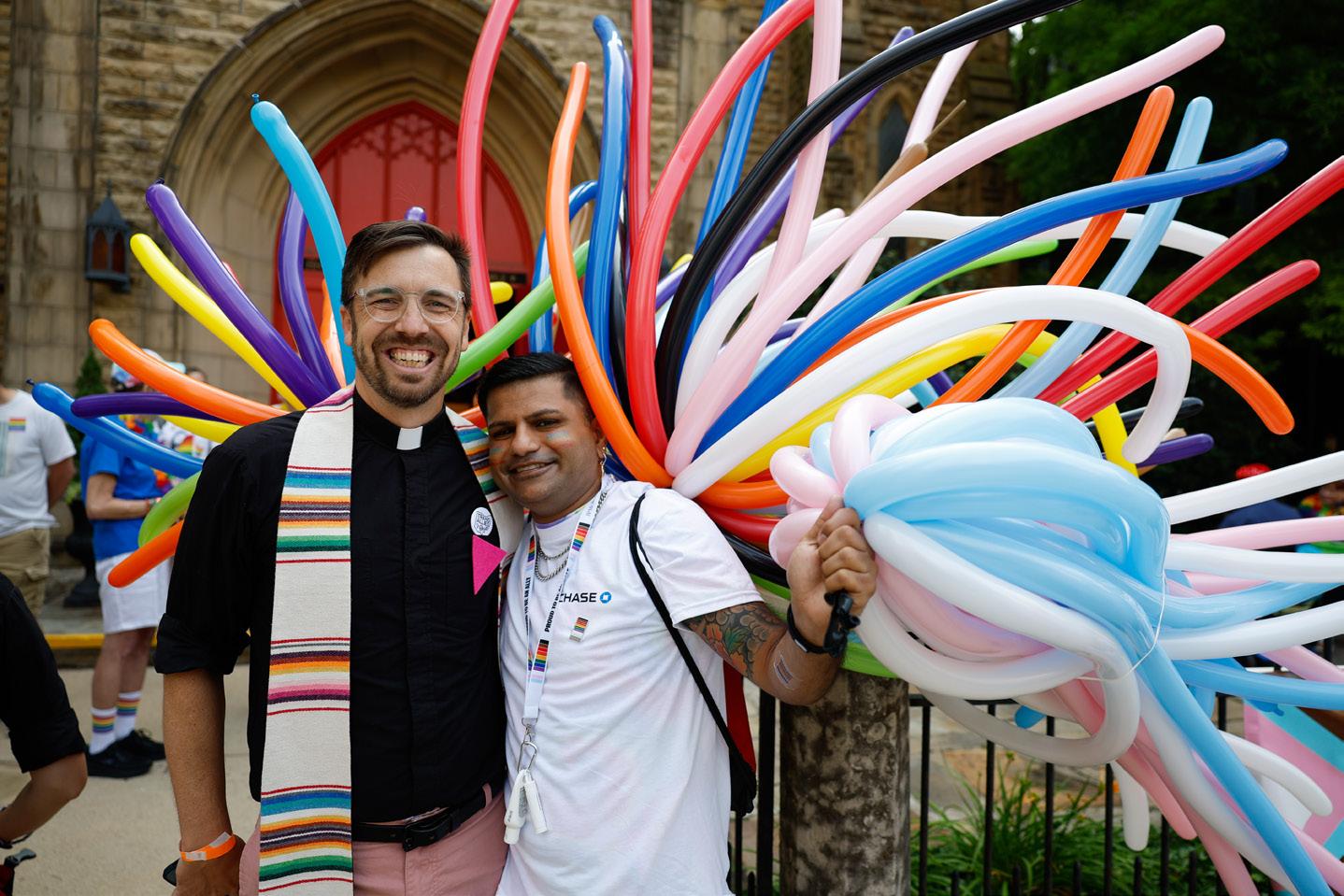


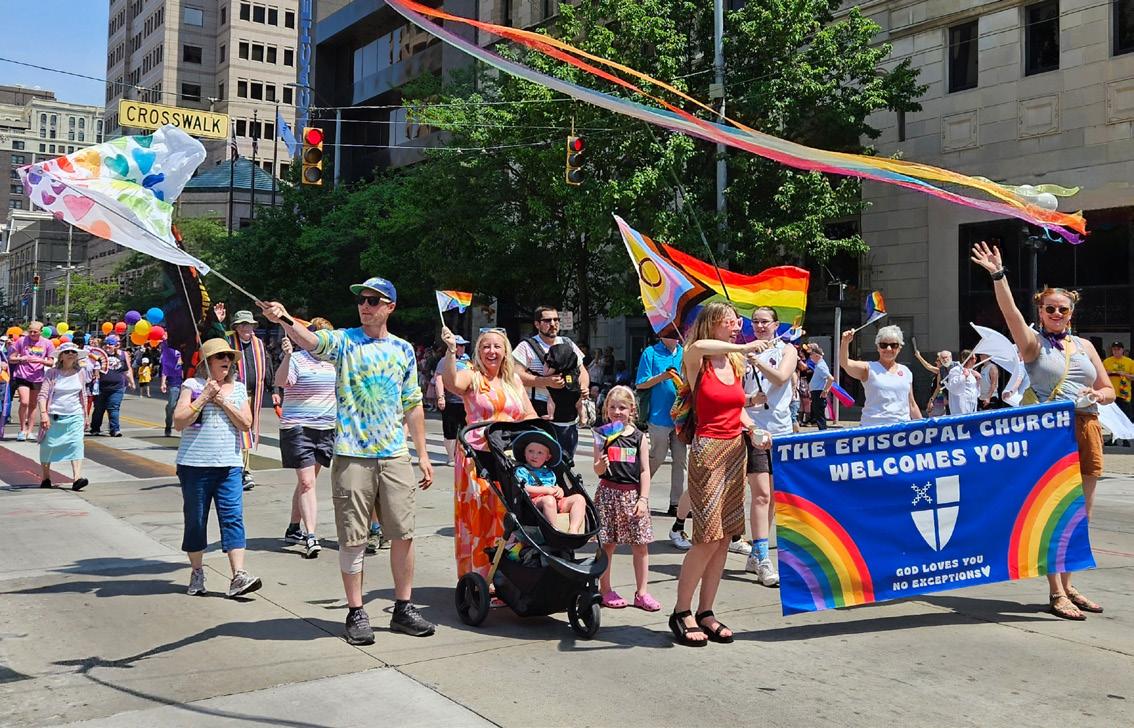
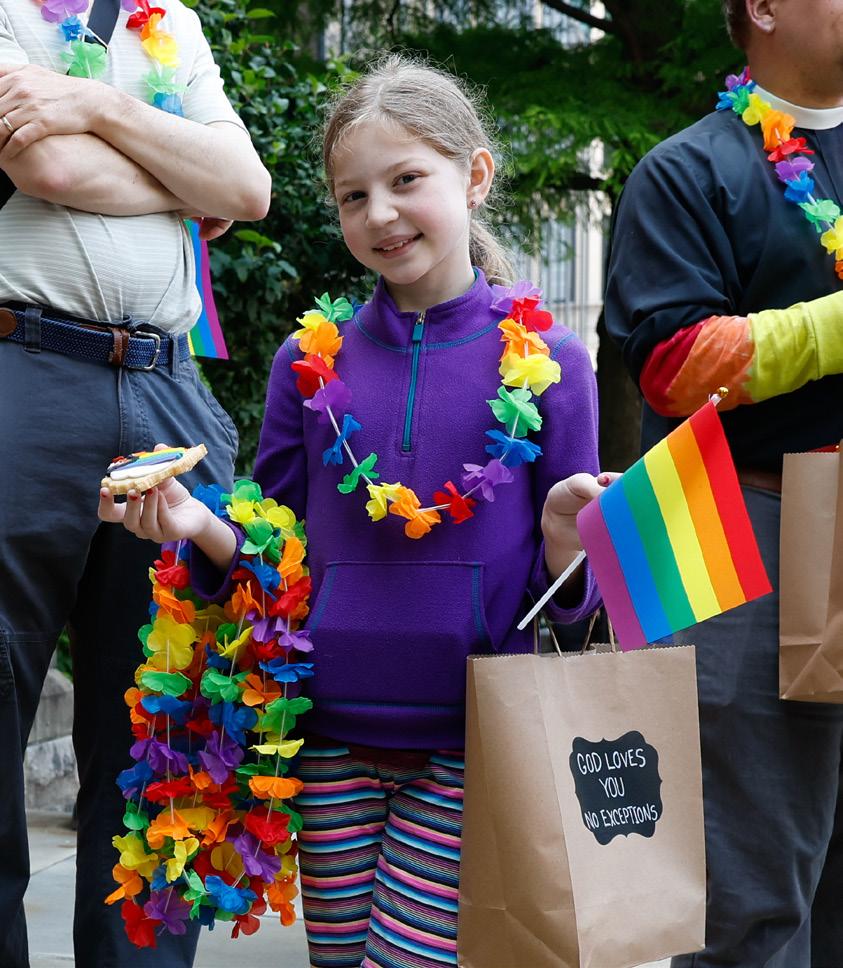



In Chillicothe and other communities, parishes share clergy, and a sense of connection.
 By Kathleen Moore
Photos by Joseph Scheller
By Kathleen Moore
Photos by Joseph Scheller
Every other Wednesday, five clergy colleagues gather to discuss the scripture readings for upcoming Sundays, plan liturgy and formation, coordinate pastoral care needs, and review budgeting, finance, and building maintenance.
While this might sound like the staff meeting of a cathedral or a cardinal parish, it is actually the biweekly meeting of the clergy cohort that shares responsibilities for four small parishes in south central Ohio— St. Philip’s in Circleville, St. Paul’s in Chillicothe, St. John’s in Lancaster, and St. Paul’s in Logan—some of which are more than 35 miles apart.
“With this model, we’ve got three priests and two deacons, all with different strengths and weaknesses that combined fill in any gap we might have,” says Mark Conrad, who serves as St. John’s senior warden. “That is a fantastic place to be for a smaller church. And not only do we have this team of clergy, we have collaboration with the other churches. So once in a while, because we have this connection, we can do something together. That could unfold in a lot of ways—it could be as simple as church picnic or as complex as four-church outreach ministry.”
Wendell Mulford, St. Paul’s, Chillicothe’s senior warden, says that his parish could no longer afford full-time clergy. “We’re in a rebuilding mode,” he says. “The benefit [of this model] is wonderful because we get all these good clergy, and you also get the benefit of multiple perspectives and multiple styles. There’s an incredible synergy with this work.”
“Each parish maintains its own identity and form of governance,” the Rev. Canon David Getreu, who serves as the rector of all four congregations, says. “I function as the administrator and deal with the operational side, and the other priests (the Rev. Rowena MacGregor, the Rev. Michael Ralph and the Rev. Stephen Smith) and deacons (the Rev. Craig Klein and the Ven. Paul Scanlan) do pastoral care, education, visit the sick, and outreach programs.
“It’s a benefit for the parishes, because they get to connect to other Episcopalians, and they’ve been so isolated,” he says. “And they get a huge variety of preaching and liturgical and ministry styles that you would normally find in a wealthy parish. The benefit for clergy is they’re not working in isolation anymore.
They are working together, and it’s rejuvenating their priesthood.”
MacGregor is already feeling the benefits of the collaboration, which began in November 2022. “It’s like night and day, it’s extreme,” she says. “As one pastor for one church in a particularly isolated situation … where, even if there was good monthly collegiality, you’re still on your own, facing things and working them out very much in an insular fashion—it’s very draining. In the last three weeks working in this collaboration, I have laughed more than I have in the last 17 years of ministry.”
“We just find ourselves laughing an awful lot,” Ralph says. “I’ve found myself looking forward to going to work for the first time in a while—this is a completely different experience in ministry.”
Scanlan says working in the collaboration “is the most collegial I have felt as a deacon working together with priest colleagues, not for a rector.” Scanlan, who continues to visit parishes across the diocese as archdeacon, stresses the importance of including deacons on the team. “Deacons bring a different aspect to liturgy and parish life,” he says. “Deacons are not called to do a to-do list. Deacons are called to bring ideas, foster the community to take what the ideas are and then to go with them.”

Clergy in the collaboration rotate preaching and presiding at each parish, so congregants have gotten to know them all. While the four congregations hold their own in-person Sunday services, they collaborate on a single bulletin and host a Sunday Zoom service together.
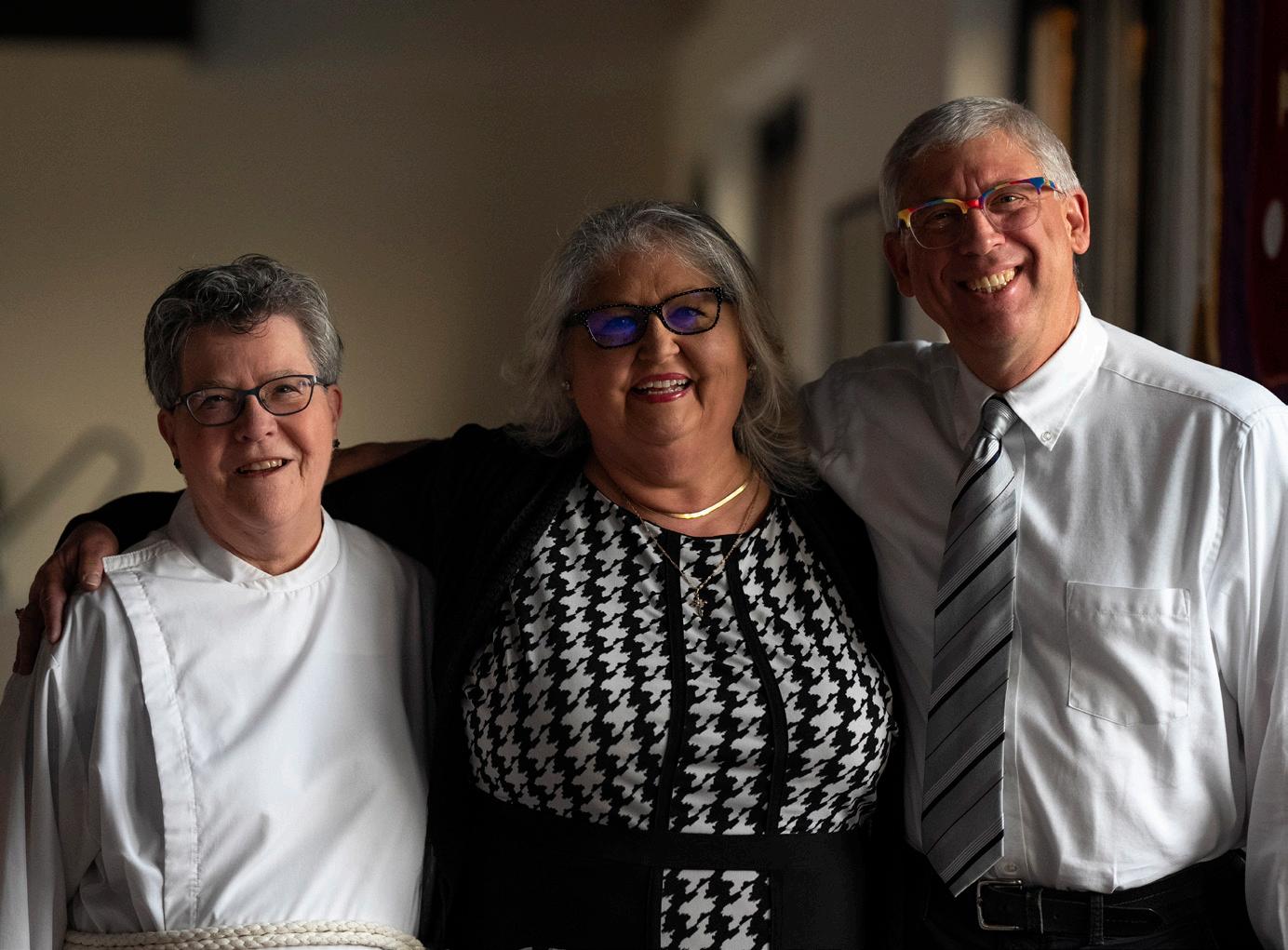
During Holy Week, which can be a grueling time for congregational staff and volunteers, Circleville and Chillicothe shared Maundy Thursday and Good Friday services, as did Logan and Lancaster, and all four congregations gathered for the Easter Vigil in Circleville. In February, during Bishop Smith’s visitation to Circleville, all four congregations sent people to be confirmed or received.
“I can honestly say our church financially and structurally is probably the best since 1968,” says Bill Parker, who has served on St. Philip’s, Circleville’s vestry many times over the years. “All the clergy are very well-thought-of and well-liked, and we see different faces on different Sundays.” Parker credits Getreu’s financial and leadership skills with helping make this model work. “Father Dave, with his financial background, has a lot to give. You need a leader; someone who has the wherewithal and the talent and the energy like Father Dave to pull all this together.”
Conrad agrees, saying that the decrease in financial strain and isolation has made St. John’s, Lancaster a healthier place. “The church is healthier, and healthy churches are much more likely to attract people. If we’re going to have church growth, this is how it’s going to happen.”
Thanks to the collaboration, newcomers are exposed to many preaching and liturgical styles and members of all four congregations, and thereby get a fuller sense of the Episcopal Church. That “makes them more likely to stick around,” Conrad says. He has observed that it is easier for members to overcome annoyances with a particular congregational custom or a certain clergy person’s style if they see their parish as part of a larger community in which faith is expressed in many ways.
The Rev. Michael Spencer, the diocese’s canon for transition and congregational ministry, believes congregational collaboration also builds resilience. “With a model like this one, with four churches, three regular priests, and two deacons, it’s a lot less vulnerable to coming apart at the seams when one component needs to change for some reason,” he says. If a priest takes another call, for example, “it takes the stress off, so it’s not, ‘my gosh I’ve got to find a priest in an era when we’re struggling to have priests at the ready.’ They’ll be able to continue to move forward without a significant loss of momentum.”
The key to successful collaboration, he says, is enthusiasm in each congregation. “Most of the time, these relationships tend to endure when they do start at the grassroots level,” he says. “The most important thing really is the members of the church—the faithful that show up week in, week out, month in, month out.
“This is a model to remind ourselves that we’re not these islands floating around—we’re all dependent on each other. When we’re all called to do the work together, then we’re stronger.”
Parishes experiment with hard conversations, celebration and commemoration.
 By Nancy Bryan
Photos by Graham Stokes
By Nancy Bryan
Photos by Graham Stokes
Since the beginning of Advent, Episcopal congregations have been hearing readings from Year A of the Revised Common Lectionary, the three-year cycle of scripture readings used by many mainline Protestant and Roman Catholic churches. Di McCullough, a member of St. John’s, Worthington, and the diocese’s Faith In Life committee, is one of the people who has helped shape the way Episcopalians experience Year A.
As a contributor to “Planning for Rites and Rituals, Year A,” an all-in-one liturgical planner published by Church Publishing Incorporated that includes readings, worship, Christian formation, and hymn suggestions for each Sunday and holy day, McCullough has created liturgically based ideas for worship and education for all ages.
“My thinking is not ‘How can I hand something down,’ but ‘Who am I working with? What gifts do they already have, and how are they already part of what we’re already doing here?’” McCullough says.
She sees Planning for Rites and Rituals as a way to help Episcopal congregations that are “trying to bless the work of God in every day experience.” She defines that work as “formation,” a word that encompasses any number of easily identified programs such as Sunday School, youth ministry and adult education that form the faith of Christians over their lives.
“Formation is inclusive and shifts the question back to relationship,” McCullough says.
“I am not an example of all people my age, so it helps me to think ‘how do I make this accessible to specific children rather than to children as a category.’ We aren’t broadly accustomed to thinking intergenerationally in the church, but we can consider how we can create activities for and with the children and adults we are around. In a small parish, it is easier to tailor to the specific individuals you know well but there is not a way to get around knowing our kids first,” she said.
Her approach is evident in congregations across Southern Ohio that are focusing on racial reconciliation in their formation efforts.
All Saints, New Albany was thinking intergenerationally when it planned a recent Juneteenth celebration. “I wanted to do more than celebrate Juneteenth,” says
Gayland Trim, a lawyer who is doing his field placement at the parish and anticipating his diaconal ordination in the coming year. “This event needed to be about education, commemoration, and celebration: educating the church and the community, commemorate the event, and celebrate the marking of the end of slavery and a step along the way as civil rights work continues.”
Incorporating the kind of educational and formational concepts that McCullough espouses, Trim planned an afternoon of fun, interactive, and tasty events as members and neighbors of All Saints learned more about Juneteenth.

The day featured two bands, one the renowned Urban Jazz Coalition; Mexican, Nigerian, Ethiopian, and Creole food trucks; an appearance by children’s book author Dia Mixon; Juneteenth crafts; a children’s area featuring games and activities, and vendors offering a variety of handmade items.
“I want the congregation and community to have left the event changed and brought closer together,” Trim says. “‘I had fun, but I learned,’ is the best possible response. I’m not doing this for me and not necessarily for All Saints, but for the greater community to celebrate people’s heritage and culture and as a way to bring people together in love. This is another step toward loving and respecting each other.”
Trim believes racial barriers are broken down through proximity and conversation. To that end, All Saints, led by its rector, the Rev. Jason Prati, has been talking about race on Sunday mornings between its two services for the last three months, using “Waking Up White” by Debby Irving as the catalyst for the conversations. The parish is considering undertaking the Episcopal Church’s
Sacred Ground curriculum, a video-based exploration of race and racism in American history.
St. Barnabas in Montgomery worked through the Sacred Ground curriculum training before the COVID pandemic took hold, and the parish’s Becoming Beloved Community Discovery, Discernment, and Action Committee was “looking for something meaningful for the congregation to get involved with BBC,” in the words of committee member Earline Fechter.
Adam Hayden, the diocese’s director of children, youth and young adult ministry, and the Rev. Canon Jane Gerdsen, the parish’s rector, pointed the group toward the Rev. Daniel Hughes, a Methodist pastor and community organizer with the Amos Project, an Ohio faith-based collaborative. In 2017, after an Ohio jury failed to convict a University of Cincinnati police officer in the fatal shooting of Sam DuBose, an unarmed Black man, Hughes and the Rev. Troy Bronsink, a Presbyterian minister, developed an eight-week program designed to create a context in which issues of racism could be safely discussed.

Meeting frequently with the committee, Hughes helped the group tailor a program to meet the congregation’s needs. It launched in the fall of 2022 with some 30 participants who met in a large single group before breaking into smaller groups, then reconvening over dinner. Every week, facilitators checked in with each participant to foster further reflection.
Bethanie Van Camp, a parishioner at St. Barnabas, said Hughes’ approach included foundational questions such as: “Who are you? Why are you here? What do you want from this experience? What are you feeling?” And Mark Stockman, another member of the congregation, said Hughes told the group, “‘We are the curriculum…’ The primary focus was on talking to each other.”
Earline Fechter, a member of St. Barnabas for almost a dozen years,
said Courage to Connect had “helped make some conversations easier to have.” While for Van Camp, Courage to Connect involved “learning different layers and levels to myself—always reevaluating, going deeper.” After a pause, she added, “It’s being comfortable being uncomfortable.”
The Rev. Pierce Leavell, chair of the Progressive Christian Alliance, has been part of the congregation at St. Barnabas for about threeand-one-half years. For him, the group’s conversation about the George Floyd murder was significant due to the diversity of childhood experiences participants shared in discussing the murder. “Some of us [Black people] were bussed to school; I was not because we moved to the suburbs after my father finished his medical residency. My twin brother and I were two of the first Black students both in our school district and our Episcopal church,” he says. “How can we have conversations that lead us to do more? How can we be loving even when bad things are happening? Courage to Connect got us moving; it galvanized us to go forward constructively as a church.”
Di McCullough says having difficult conversations in an atmosphere of trust and support is at the core of Christian formation. “It’s not about what I [as a formation leader] can do for these people, but what I can do with these people whom I know and love.
“You know the quote: ‘Being listened to is so close to being loved that sometimes we can’t tell the difference’? When we listen, we’ll know what to do with both children and adults.”

“‘I had fun, but I learned,’ is the best possible response.”
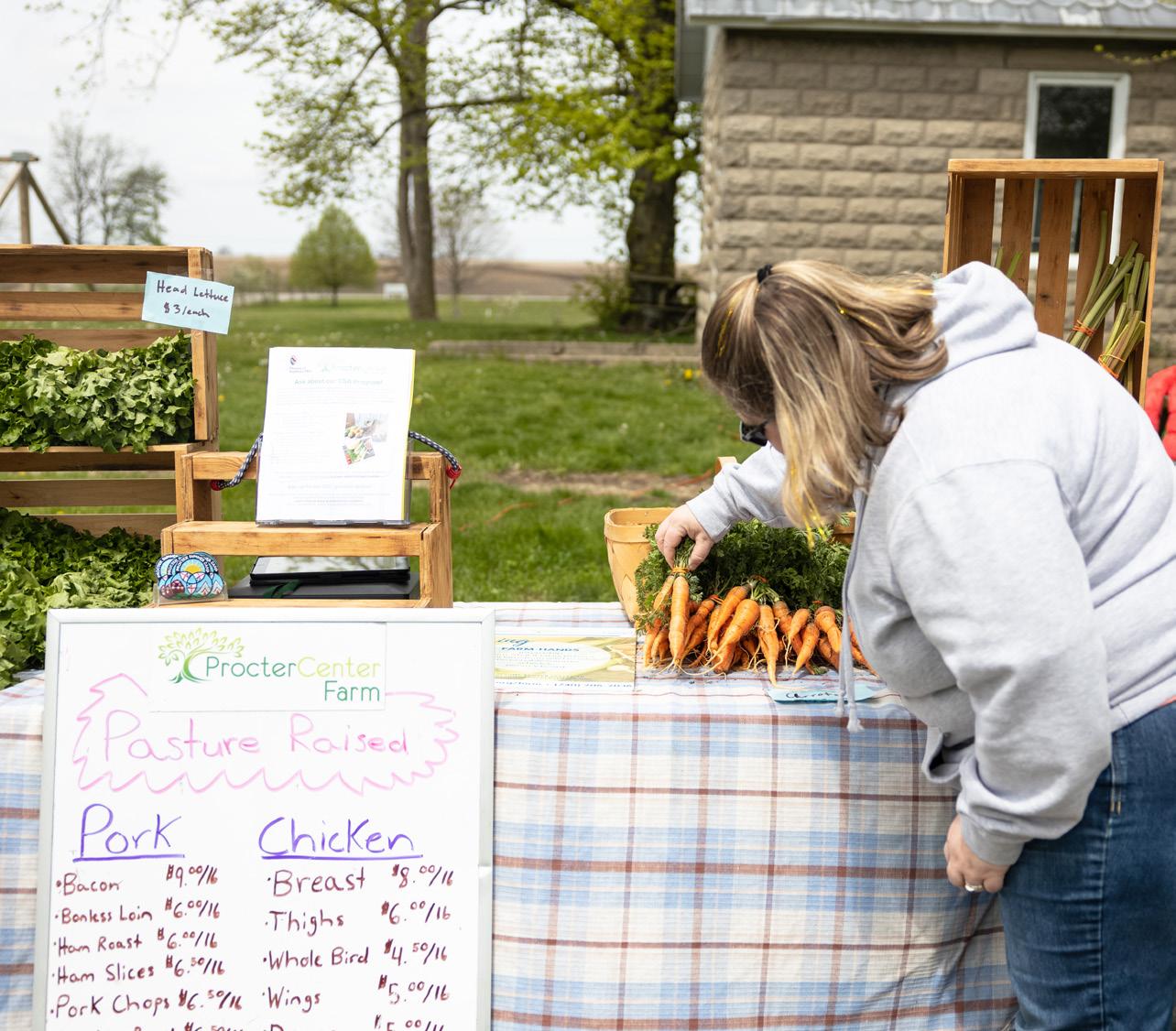


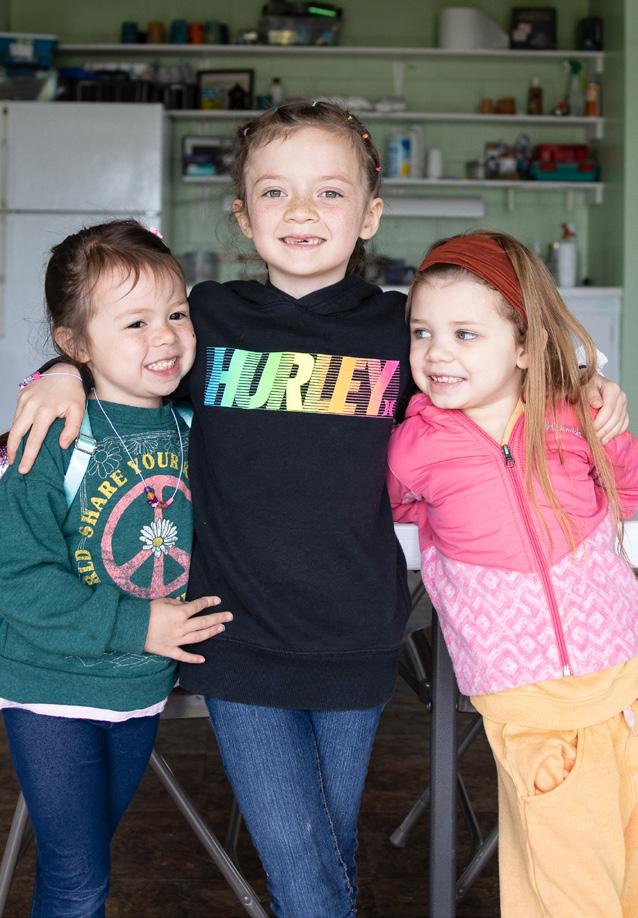 PHOTOS BY MEGAN JELINGER
PHOTOS BY MEGAN JELINGER

Before the blessed bustle of summer camp, which is now in session, Procter Center held its annual open house, an opportunity for people from across the region to renew—or initiate—their relationship with the simple solitude and spare beauty of the diocesan camp and conference center. “We want everyone in the diocese to feel like Procter is for them—a place to learn, love and become part of the Beloved Community that God longs for us to be,” said the Rev. Jason Oden, canon for formation. “This is the summer to return to Procter.” An overcast spring day wasn’t bad either.

Before I became treasurer at last year’s convention, I had been an Episcopalian for more than forty-five years. But I was born a Baptist.
I do not remember a time when I was not in church. My family belonged to Second Baptist in Columbus, where the pastor was my grandmother’s cousin. Church every Sunday was mandatory. Sunday school started at 9 a.m. and we were lucky to get out by 3 p.m.
St. Philip Episcopal Church was located a block away. My best friend attended St. Philip, so one day I decided to make sure my elders saw me and then I sneaked over to St. Philip. I kept doing that on Sundays, and I never got caught. As a teen, I even joined the St. Philip Youth Group. My grandmother told me I was going to die and go to hell.
I found my way back to the Episcopal Church when I met my husband, Deryck. We dated for five years before getting married. During that time, he told me he was a cradle Episcopalian/Anglican and asked if I could recommend an Episcopal church. I was living in Westerville and referred him to St. Matthew’s. We would attend my Baptist church one Sunday and St. Matt’s the next. Before he proposed, he asked me to agree to raise our children in the Episcopal Church. I had already been married, divorced, and had two children. As I had no intention of having any more, I agreed.
Fast forward to my son, Father Christopher Richardson, who is now the priest-in-charge of St. John’s, Columbus, and the diocese’s associate for curriculum development. I have often said that God has a sense of humor by giving me this priest as a child. (Jeremiah 1:5 says “Before I formed you in the womb, I knew you and before you were born, I consecrated you.”)
When Christopher felt called to be a priest and entered the ordination process in a predominantly white church, it triggered what I call my “Black Momma”
persona. I felt the need to find out as much as possible about the Episcopal Church. I started by enrolling in SOLLI (the Southern Ohio Lay Leadership Initiative). Bill Ubbs was the presenter and taught us the history and structure of the Episcopal Church. Soon after, I began taking on more leadership roles with St. Matthew’s and the diocese.
My expertise is accounting. I find it exciting, fun, creative, and at times, suspenseful. I believe God gave me this talent and, according to God’s will, I am to give tithes and talent to the church. As such, I have served on a wide variety of committees, commissions, and ministries.

I have seen changes in the way the structure and administration of the business side of the diocese works. My first volunteer position was on the Budget Committee in 2010. I remember asking David Robinson, CFO, how much the bishop made. He was not allowed to tell me. There was mistrust toward the diocese among the churches and parishioners. Black churches especially, and their members, felt totally left out regarding general information and opportunities like grants.
During this bishop transition, I have been working with my colleagues to overcome past setbacks that have cultivated mistrust about our diocese’s historic past and lack of financial transparency. While we are not there yet, I hope that the people of the diocese are beginning to see and believe that the diocese is on their side. One thing that has taken place is total disclosure regarding the new bishop’s compensation. Another is a commitment from the Trustees to finance a Black missioner. It is my belief that the diocese is trying to bridge the gap between congregations and diocesan staff, renew faith in the business structure, and promote transparency about significant issues.